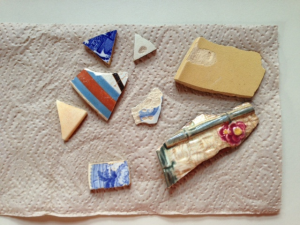Trash?
Here you see the fruits of a Sunday walk along the harbor – another of my favorite things to collect. The recent storms have swept some areas clean and in others, they have helped to deposit treasures stirred up from the bottom of Nantucket Harbor – something that once served as a dumping ground among other uses in the nineteenth century and earlier.
These are pottery shards of various ages. Looking at them closely, they are mid to late nineteenth century (the blue and white pieces – in particular the lighter blue pieces) and possibly all the way up to the 1930s or so with the largest piece on the bottom right having a floral and bamboo/basket decoration that reminds me of McCoy ware. I will have to see if I can find any such pattern with them – it could very likely be another pottery maker, from the early to mid- twentieth century but maybe even the late nineteenth century!
But in any case, it tells a story of what Nantucketers used in their homes. Each time we have a hard rain, shards will appear in the yard of the Mitchell House where the family tossed out some of its trash that slowly became a part of the landscape and the earth. When a sewer pipe was re-done the plumber left the shards that he had found for me – I think he knows me too well! (The family has worked on MMA plumbing since the MMA had running water – early 1900s.)
One piece reminds me of mochaware but I think it might be a much later copy though I do hope I am just being cautious and this really is a 19th century shard of mochaware. That too I will have to investigate. Mochaware was started in the late 1700s in England and was just about the cheapest pottery one could get then and into the nineteenth century. Maybe akin to Fiestaware which while many collect it today used to be given out at the grocery store and the movies!
In any event, take a look around you. Look down and up – observe! (“We see most when we are most determined to see,” according to Maria – how right she was!) You never know what your feet are treading over and you never know what you might find – it might whisper something about those who once lived in the houses and neighborhoods we now inhabit.
JNLF
Recent Posts





